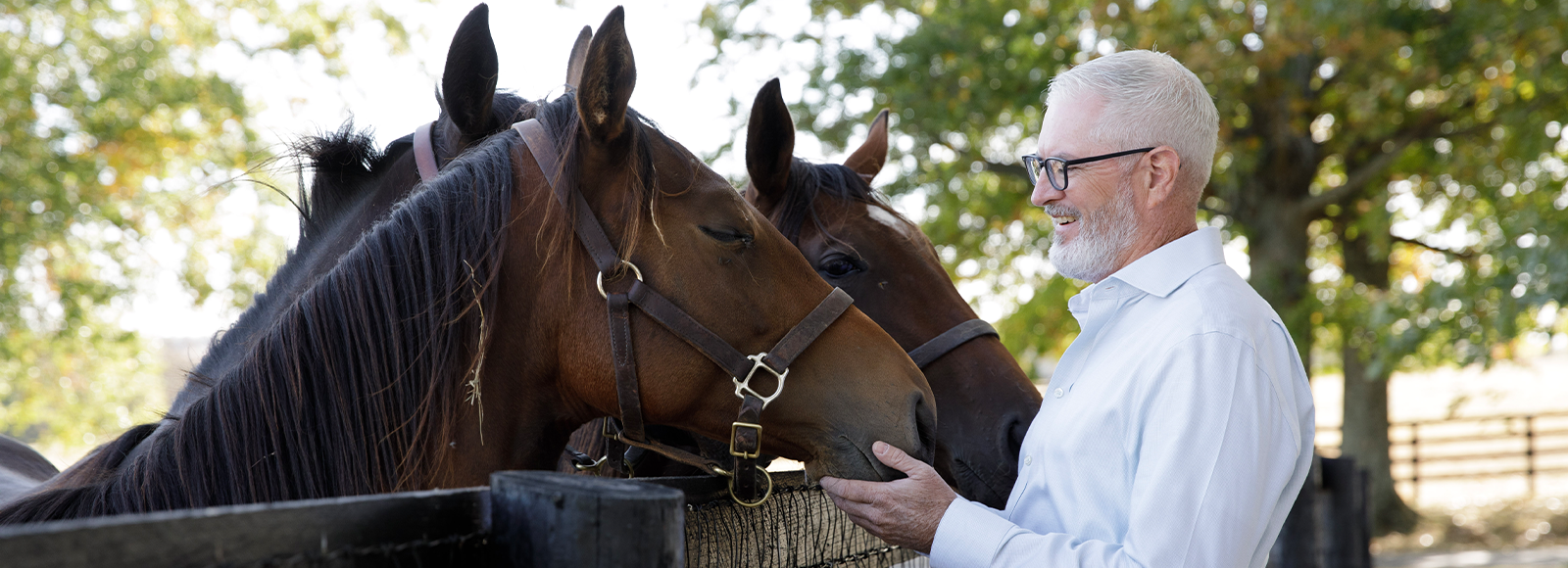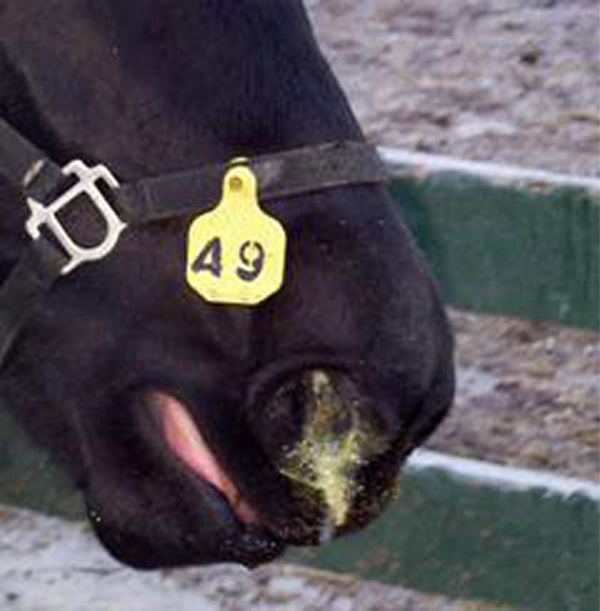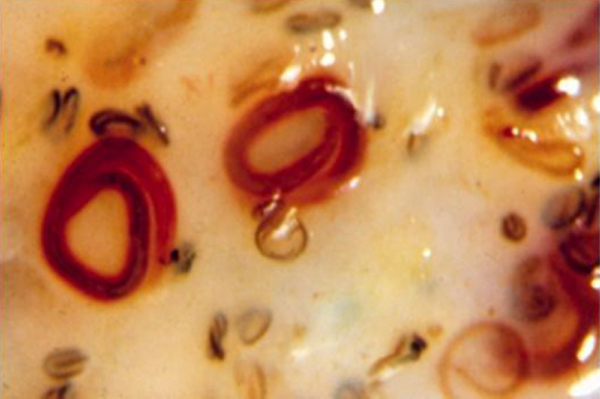
Equine Health Library
Young Horse
Wellness & Prevention
Immunology | Parasitology | Nutrition | Dental Care | Hoof Care
Young horses’ immune systems are still immature, which renders them more susceptible to common respiratory viruses and parasites. Plus, their skeletal systems are still developing with many of the growth plates still open.
You may notice this stress affecting your young horse’s health as upper respiratory tract diseases, ulcers or certain musculoskeletal problems. If your horse moves to a training barn where other horses are coming and going, the risk for infectious disease only increases, especially viral respiratory diseases such as equine influenza virus (EIV) and equine herpesvirus (EHV).
Make sure your veterinarian sees your growing horse at least twice per year for scheduled visits and more frequently if your horse’s demeanor or behavior changes. Developing horses can experience lameness and neurological problems related to growth, management (including diet), handling and training, so open communication with your veterinarian is critical for your horse’s long-term health and soundness.
Key healthcare action items for young horses (1-2 years of age)
- Pre-purchase exam for all sales
- Annual physical including eye, dental and lameness exams as well as body condition scoring and evaluation of conformation
- Blood work (CBC/chemistry) and fecals for horses showing loss of condition without an obvious cause
- Timely fecal egg counts in case your horse requires a change in deworming regimen. Young horses are highly susceptible to most internal parasites
- Routine farrier care
Immunology
Immunology
Yearlings and two-year-olds are at increased risk of getting sick if they come into contact with a variety of infectious viruses and bacteria. Young horses are especially susceptible to Equine Eastern Encephalomyelitis (EEE), Equine Influenza (EIV), Equine Herpesvirus (EHV) 1 & 4, and Streptococcus equi (Strangles).
Vaccination is a critical component in protecting against any disease, but for a young horse, vaccination is critical for developing their immune system.
Prevent Diseases by Vaccinating Now
Vaccines are helping to develop a young horse’s immune system’s “memory.” In this way, vaccination helps the immune system build protective responses to future challenges by infectious pathogens. Many young horses change ownership during this time period, and their past vaccination history might be uncertain. It is best to discuss an appropriate vaccination strategy with your veterinarian.
Due to immature immunity, the stress of new situations and possible contact with many other horses in a training facility, your growing horse is at the highest risk for contracting an infectious disease. That’s why you and your veterinarian should consider upping your horse’s protection by using vaccines that stimulate a more protective, relevant immune response.
An intranasal vaccine such as Flu Avert® I.N. is administered directly onto the nasal mucosa. Because it can stimulate protection right at the site of infection, it’s very effective at preventing equine influenza.
A thorough risk assessment analysis performed by your veterinarian can help determine the type and frequency of vaccine best suited to keep your youngster free of disease.
Action Item
Talk to your veterinarian about a vaccination protocol for your young horse. For more information on core and risk-based vaccinations, visit the AAEP to read the AAEP vaccination guidelines.
Click the link to download a vaccination record for your young horse. Equine Health Library Young Horse Vaccination Guide.

Nasal discharge in young horse with influenza virus infection. Other signs of influenza infection include a high fever and dry, hacking cough.
Parasitology
Deworming the Pleasure Horse
In strategic deworming, veterinarians determine shedding status by fecal egg counts and then create an appropriate plan focusing on treating the right horse at the right time for the right parasites.
Because of their immature immune systems, horses under the age of three should be treated as high parasite shedders. It’s critical at this life-stage to work with your veterinarian to develop a quality deworming program.
Keep track of your horse’s deworming by downloading this form. Equine Health Library Young Horse Deworming Record.
Deworming tips
- Deworm based on fecal egg counts and guidance from your veterinarian.
- Most young horses will require four to six dewormings per year depending on their fecal egg count exams and other important management considerations, such as stocking density (how many horses per pasture), manure removal system, feeding practices (fed off the ground or in bunkers/rack) and condition of pasture (dry lot or grass).
- Drought and high temperatures will effectively eliminate most strongyle larvae exposed on pastures. Ascarids are hardier and more resistant to temperature extremes. Unfortunately, cold weather and snow do not rid most pastures of parasites, including ascarid eggs and strongyle larvae.
- The choice of dewormers will be affected by the target parasite, the history of drug use on the farm and whether or not drug-resistant parasites have been detected. Many yearlings may still harbor ascarids, and this parasite should still be considered one of the target parasites during year two of life. With that in mind, larvicidal dosing of fenbendazole should be considered
- Most deworming treatments should be administered during periods of parasite transmission and not during cold winters or hot, dry seasons. In most regions of the country, spring and fall remain important times of parasite transmission. In southern climates, mild winters are also conducive to parasite transmission. Periods of drought help control certain parasite populations (e.g., small strongyles) on pastures. In contrast, periods of unusually wet, warm weather are optimal conditions for parasite development.

Encysted small strongyle larvae within large colon wall. It is important to remember that a fecal egg count does not reflect the number of encysted (hibernating) small strongyle larvae.
Download The Science of Unique Deworming.
Parasites of Concern
Having a basic understanding of the parasites that can be a risk to your young horse can help you better understand the importance of a strategic deworming program. For young horses, ascarids are a primary target of parasite control programs.
Ascarids (roundworms) are often found in foals, weanlings, and yearlings. Infective ascarid eggs are ingested by the horse and immature ascarid larvae migrate through the liver and lungs before arriving in the small intestine where they will mature to adults. Clinical signs include respiratory disease, weight loss, diarrhea, impaction colic and bowel rupture.
Click here to learn more about ascarids.
Small stongyles (cyathostomes) are considered the primary parasite problem in horses today. They burrow and encyst in the lining of the large intestine and can stay there for years evading the effects of most dewormers. Eggs are laid in the pasture and hatched larvae are ingested by the horse. Depending upon the worm burden, the clinical signs range from none to poor performance, dull hair coat, recurring colic, diarrhea, weight loss and even death.
Click here to learn more about small strongyles.
Large strongyles (bloodworms) used to be the greatest threat to horses. Although their role has lessened they can still cause problems. The larval stages are ingested on pasture and migrate through the walls of certain abdominal arteries resulting in inflammation and blood clots that can block circulation to the large intestines or result in rupture of the arteries. These parasites can also damage the liver and other internal organs. Clinical signs include weight loss, anemia and fatal thromboembolic colic.
Click here to learn more about large strongyles.
Horse botflies are an irritation inside and out. The female flies look like bees and lay tiny yellow eggs on horses’ legs, manes and flanks. These eggs irritate the horse and cause them to lick and chew the affected areas allowing the larvae to enter the mouth and travel down to the esophagus where they attach to the stomach wall. Clinical signs can include an inflamed mouth and/or tongue, stomach irritation, gastric ulcers and colic.
Pinworms are a cause of tail rubbing since the female lays her eggs in the perianal region. Immunity may occur as the horse ages.
Click here to learn more about pinworms.
Tapeworms require an intermediate host. The eggs passed in the stool are ingested by a mite and the tapeworm undergoes development within the mite. The horse ingests the mite while grazing and the cycle continues with the tapeworm maturing. It is difficult to confirm the presence of tapeworms with regular fecal exams. Clinical signs include colic and intestinal blockage. The prevalence of tapeworms varies by region of the country.
Nutrition
Feeding the Pleasure Horse
Growing horses fed high-energy diets with nutrient imbalances may gain weight faster than tissues – including bone, tendons and ligaments – can properly develop. These imbalances can lead to skeletal problems such as developmental orthopedic diseases.
On the other hand, feeding low-energy diets or diets with inadequate nutrient content may contribute to, or simply delay, the onset of developmental problems by limiting growth rate and quality of growth.
The best option is to feed good quality forage in appropriate amounts, along with a product designed to supply adequate essential nutrients to support optimal growth.
Light Training
Yearlings and two-year-olds in light training need a greater percentage of their nutrients to come from a concentrate in order to support exercise, as well as provide nutrition for growth. Generally, only 40 to 50 percent of these young horse’s nutrients can be supplied by roughage, compared to 65 percent or more for an adult horse in light work.
Feeding too much grain in one meal can overload the stomach and cause problems such as colic or laminitis. A general rule of thumb is to feed no more than 0.5 percent of the horse’s body weight in grain per meal – or no more than 3 pounds of grain for a 600-pound growing horse.
If you feed a balanced concentrate, do not dilute it with oats or other cereal grains or grain products. Diluting your balanced feed will at best cause imbalances in the nutrient profile and, at worst, create nutrient deficiencies.
Feed High-Quality Forage
A growing horse needs at least 1 to 1.5 percent of body weight in forage (on a dry matter basis). That’s 6 to 9 pounds of hay, or 18 to 27 pounds of pasture, per day for a 600-pound youngster. Inadequate amount or poor-quality forage may lead to digestive disturbances and will not provide adequate nutrition to meet the needs of a growing horse.
If good quality hay or pasture is not available, look for a diet designed to be fed as a complete feed that includes quality forage sources to meet the needs of growing horses.
Heavy Work
As your horse matures past his two-year-old year, be sure to feed based on energy needs to maintain proper body weight and condition. Larger breeds or more slowly maturing horses may need to remain on feeds formulated specifically for growth, while more early maturing horses, especially those in training, may be better served by transitioning to a diet that will support their remaining growth and exercise.
A young horse in heavy work or intense training will have much higher energy needs and may require a higher calorie performance feed.
Dental Care
Dental Care Every Horse Needs
Dental Care for the Young Horse
The deciduous teeth of the second, third and fourth premolars are shed at approximately 2.5, 3 and 4 years of age, respectively. The permanent teeth erupt under the roots of the deciduous teeth.
Occasionally the deciduous premolars (called caps) may remain attached to the permanent premolars and can cause soft tissue lacerations on the inside of the mouth. Retained deciduous teeth also can delay normal eruption of permanent teeth, which can become impacted and lead to abscess formation. A routine dental exam can identify these problems.
Growing horses need an annual physical including eye, dental and lameness exams, as well as body condition scoring and evaluation of conformation.
Click the link to download a dental record for your young horse. Equine Health Library Young Horse Dental Records.
Hoof Care
Farrier Care for the Pleasure Horse
Your young horse should be seen by a qualified farrier every six to eight weeks for routine trimming.
Don’t know a qualified farrier? Click here to Find a Farrier or ask your veterinarian for a recommendation.
